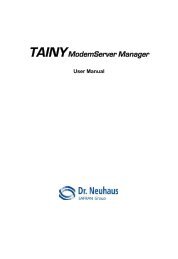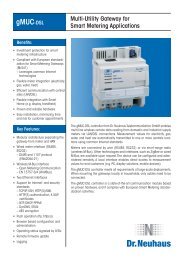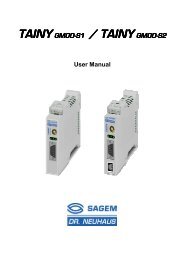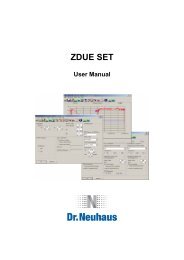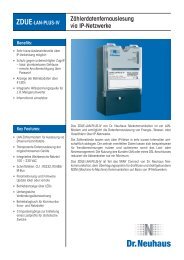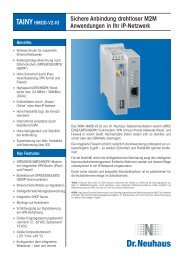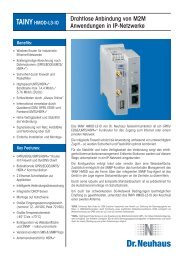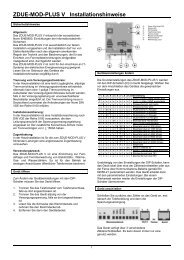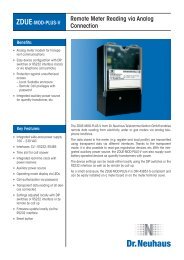tainy hmod-v3-io, tainy hmod-l3-io - Dr. Neuhaus ...
tainy hmod-v3-io, tainy hmod-l3-io - Dr. Neuhaus ...
tainy hmod-v3-io, tainy hmod-l3-io - Dr. Neuhaus ...
Create successful ePaper yourself
Turn your PDF publications into a flip-book with our unique Google optimized e-Paper software.
Remote access<br />
SSH remote access port Default: 22 (factory setting)<br />
Firewall rules for SSH<br />
remote access<br />
You can define an alterative port. However, if you have defined an<br />
alternative port, then the external remote stat<strong>io</strong>n conducting the remote<br />
access must specify the port number defined here in front of the IP address<br />
when specifying the address.<br />
Note<br />
Addit<strong>io</strong>nally to the new selected port, the standard port 22 for SSH remote<br />
access keeps open.<br />
Example:<br />
If this TAINY xMOD can be accessed from the external network using the<br />
address 192.144.112.5, and if port 22222 has been defined for the remote<br />
access, then this port number must be specified in the SSH client (e.g.<br />
PUTTY) at the external remote stat<strong>io</strong>n:<br />
SSH -p 22222 192.144.112.5<br />
Example for console:<br />
New Adds a new firewall rule for SSH remote access that you can<br />
then fill out.<br />
Delete Removes a firewall rule for SSH remote access that has been<br />
created.<br />
From IP<br />
(External)<br />
Specify here the address(es) of the computer(s) for which<br />
remote access is allowed. You have the following opt<strong>io</strong>ns:<br />
IP address or address range: 0.0.0.0/0 means all addresses.<br />
To specify a range, use the CIDR notat<strong>io</strong>n - see Chapter 11.<br />
Act<strong>io</strong>n Define how access to the specified SSH port will be handled:<br />
Accept means that the data packets can go through.<br />
Reject means that the data packets are rejected, and the<br />
sender receives a message about the reject<strong>io</strong>n.<br />
<strong>Dr</strong>op means that the data packets are not allowed through.<br />
They are discarded without the sender receiving any<br />
informat<strong>io</strong>n about where they went.<br />
Log For each individual firewall rule you can define whether the<br />
event should be logged when the rule takes effect - set Log to<br />
Yes,<br />
or not - set Log to No (factory setting).<br />
The log is kept in the firewall log, see Chapter 6.4.<br />
Page 78 of 111 TAINY xMOD





